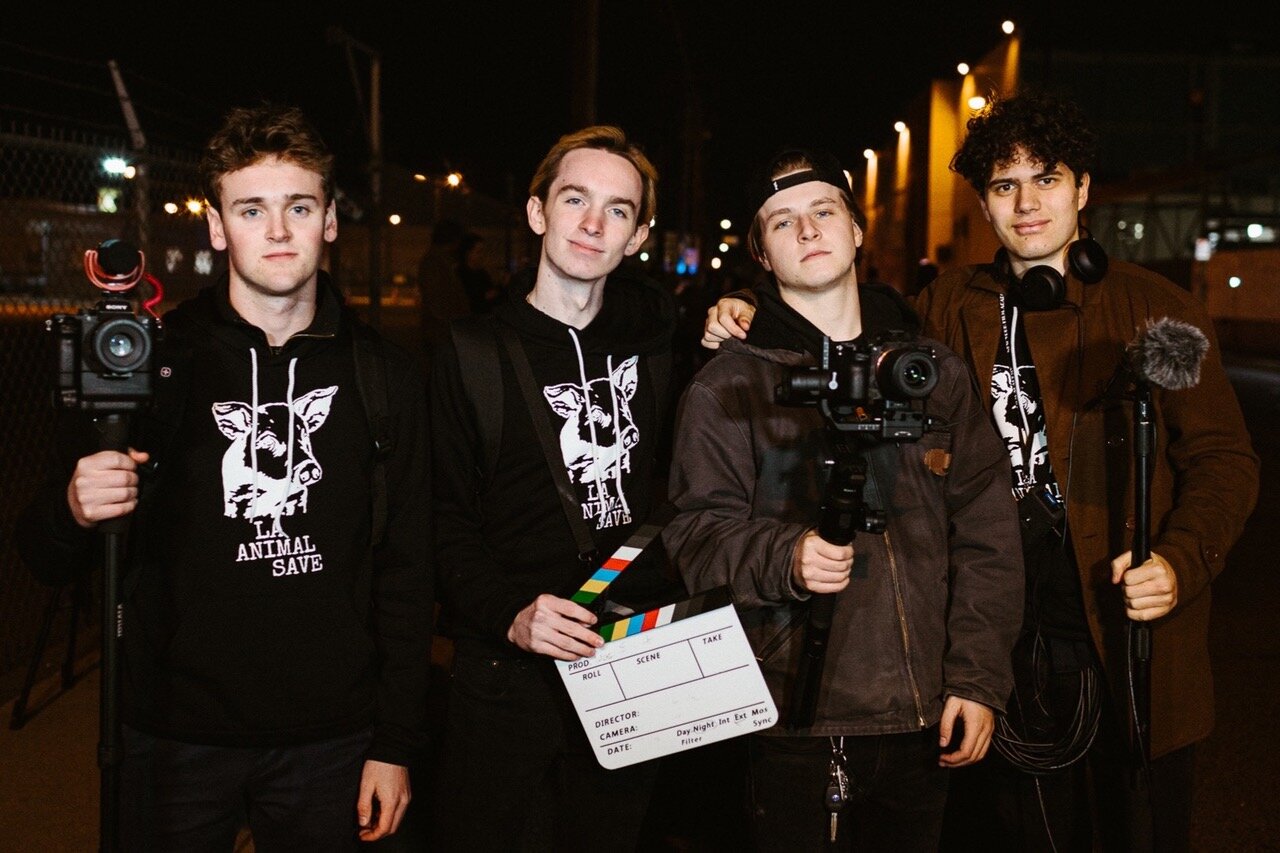By Lisa Biehle Files
Despite the confinement and anxieties surrounding this past year, 149 students age 8 to 25 managed to make and submit films to the One Earth Young Filmmakers Contest. Of those, 10 films will receive top prizes at 3 p.m. Saturday, March 13, in the Awards Celebration, while 15 Honorable Mention films will be screened during the Earth Day Festival in April.
Perhaps because of Covid-19 restrictions, more young people than ever experimented with animation and stop-motion to convey their increasingly urgent messages about climate, energy, food, transportation, waste, water, or wildlife and ecosystems.
In the animated film “Homo Sapien Virus” the Earth gets a terminal diagnosis.
The Young Filmmakers Contest asks students to create a 3-to 8-minute live-action film or a 45-second minimum animation/stop-motion that inspires environmental change or action. Prizes ranging from $100 to $1,000 are awarded at all age levels: elementary school, middle school, high school, college, and post-grad, with additional awards for creativity and animation.
Most winners also receive a matching gift to donate to a nonprofit of their choice that supports the theme of their film.
This year, a new $350 Prize for Activism was added to the accolades in honor of the late Sally Stovall, founder of One Earth Collective’s original nonprofit, Green Community Connections. While raising funds for the already-established Sally Stovall Planet Warrior Award for Creativity ($1,000), Sally’s energetic widower, Dick Alton, tapped into an overflow of largesse, allowing for this bonus Activism Award in 2021.
“The Very Hungry Ducky” consumes tempting party leftovers, including plastic waste.
In addition, ‘Wild Ones—Native Plants, Natural Landscapes’ provided an Environmental Sponsorship Award of $400 to go to the filmmaker who best expresses the integrated nature of ecosystems by promoting native plants, shrubs, and trees. These funds were provided by an anonymous donor. Instead of receiving a matching gift to donate, the winner’s film will be posted on Wild Ones website for one year.
"We hope to expand by creating even more prizes in collaboration with other like-minded non-profits," said Young Filmmakers Contest Founding Director Sue Crothers. "Our goal is to bring more attention to these young activists and their voices."
All are invited to see these winning films when they premiere at 3 p.m. Saturday, March 13, in the Young Filmmakers Awards Celebration, as part of the One Earth Film Festival. Free tickets available here.
Elementary School Award
“Never Too Small” (5 min)
($100 + $100 matching gift donated to World Wildlife Fund)
Mason Mirabile
Mason Mirabile
Grade 5, Discovery Elementary School
Arlington, Virginia
Borrowing a phrase from Greta Thunberg for his film, young Mason marches straight to the World Wildlife Fund to discuss climate change with two experts. Dr. Nikhil Advani explains that global warming is causing extreme weather events, especially fires and floods. What sounds like musical pattering of rain is the score in a minor key composed by Mason himself. Grace Lee talks about avenues for action through marches, community gardens, and conservation.
In his submission, this is what Mason writes: “The Earth is dying. Climate change is the most important issue the world is facing today. I want to challenge everybody who watches my film to look within themselves for how they can help. . . . Kids have powerful voices, and I hope my film encourages everyone to use their voices to make a difference.”
Middle School Award
“A Turtle Tomorrow” (5 min)
($200 + $200 matching gift donated to Sea Turtle Conservancy)
Andy Deng
Andy Deng
Grade 8, Herbert Hoover Middle School
Potomac, Maryland
Snorkeling quietly next to sea turtles in Hawaii inspired Andy to create his film about this endangered species and what we can do to protect them. Sea turtles face three major threats, he explains: pollution, light, and bi-catch. Dr. Daniel Evans and Evan Cooper of the Sea Turtle Conservancy explain further. First, turtles are harmed because they often mistake plastic bags for jellyfish, their largest food source. Second, light pollution prevents sea turtles from nesting, and third, fishermen accidentally catch sea turtles in their nets. Reducing plastic waste, using less intrusive red LED lights, and employing a turtle exclusion device in fishing can all help save sea turtles. Andy writes: “Turtles have survived through multiple eons, from the age of the dinosaurs to today. Problematically, scientists fear that sea turtles will not survive because of humans.”
High School Award
“Plastic Crisis: Our Oceans in Peril” (6 min)
($350 + $350 matching gift donated to Plastic Ocean Project)
Shannon Germaine
Shannon Germaine
Grade 12 (Age 14), Clonlara School
Ann Arbor, Michigan
Shannon urgently narrates her compelling script about plastic overproduction and its impact on oceans, wildlife, and people. Instead of promoting recycling, she bravely urges people to take political action to stop making plastic entirely. Shannon interviews experts from Greenpeace, the Pacific Marine Mammal Center, and Plastic Ocean Project to bolster her message. Bonnie Monteleone from Plastic Ocean Project urges people to develop new materials that “work better with nature.”
In her contest submission, Shannon writes this: “I am a young filmmaker who wants to make a difference and call attention to the catastrophic effects of plastic waste in our world. The plastic we create today will be on this earth for many generations; there is no ‘undo’ button. Yet single use plastics continue to dominate our lives. I hope that I will call attention to this problem through my documentary short film.”
“Eyes” was a group project directed by from left, Alex Kumph, Zachary Goodwin, Alex Flanagan, and Flynn Harris.
College/University Award
“Eyes” (6.5 min)
($1,000 scholarship + $1,000 matching gift donated to Animal Alliance Network)
Zachary Goodwin, Flynn Harris, Alex Flanagan, Alex Kumph
Sophomores, New York Film Academy
Los Angeles, California
In describing how this film came about, here’s what Zach says: “My mother has been vegan for roughly 3 years now, and even though she begged me to [go vegan] with her, I refused. Once we moved to Los Angeles, she started participating in activism events. After many tries, she got me to go to one of these events. . . . It was such a profound experience, I felt very obligated to share this with the world the best way I know possible: filmmaking.”
The event Zach describes is an LA Animal Save Vigil. During these peaceful events, animal rights activists wait on the side of the road for truckloads of pigs to stop for 2 minutes of compassion before heading to slaughter. During those 2 minutes, the activists spray the pigs with water, stroke those they can reach, and look into their eyes. Zach and his team interview participants, including police who support the activists by keeping the vigils orderly. This moving film skillfully tells an emotional story without judgment.
Post Graduate Award
“The Very Hungry Ducky” (2 min)
($1,000 + $1,000 matching gift donated to Plastic Pollution Coalition)
Ariel Song
Ariel Song
Recent graduate, Ringling College of Art and Design
Sarasota, Florida
“The Very Hungry Ducky” starts out as a happy, Pixar-like, CGI-animated film about a small duck. He eats the usual fare: worms, bugs, and fruit, until one day he comes across leftover junk food from a party and gobbles away. He then ingests colorful wrappers, popped balloons, and plastic waste as the sky darkens. In a nod to Chris Jordan’s famous photographs of albatross on Midway Island, ducky’s end is not a happy one.
Writes Ariel: “I grew up working with animals, as I spent most of my high school career at a pet hotel, a rabbit shelter, and in more recent years, interning as a zookeeper at the Oakland Zoo. Art and wildlife as well as the effects of pollution on our environment and on that same wildlife ended up being the main inspirations in creating. . . ‘The Very Hungry Ducky.’ . . .To be able to draw more attention to the issue of pollution and its effects on our planet and wildlife would mean the world to me.”
Ariel is now a storyboard artist at Dreamworks in Los Angeles, Calif.
Wild Ones Environmental Sponsorship Award
“A Home for us All” (3 min)
($400 + film to be posted on wildones.org beginning 3/14/21)
Lena Song
Lena Song
Grade 10, Oakton High School
Hendon, Virginia
Lena creates a complete neighborhood out of origami in her stop-motion film. First, she shows deer, rabbits, foxes, and birds living at one with nature until the area is deforested to build a housing development. Lena points out how wasteful and harmful lawns can be, using 3 trillion gallons of water, 200 million gallons of gas (to mow), and 700 million pounds of pesticide each year. She then demonstrates how we can rethink and rebuild our urban environment by planting native perennial plants to bring back wildlife, especially if several neighbors participate to create a “wildlife corridor.”
As Lena writes, “Creating this stop motion allowed me to present a current problem about the environment that must be solved through everyone's cooperation. . . . Although people need homes, native species do too. A home for us can be a home for everyone, and adding native plants to your lawn can be the first step to saving the environment and wildlife around us.”
Animation Tie/Split
“The Homo Sapien Virus” (2 min)
($500 each + $500 matching gift donated to
Clean Air Task Force)
Andrew Wang
Andrew Wang
Grade 11, Adlai Stevenson High School
Lincolnshire, Illinois
In Andrew’s film, planet earth is feeling sick and sees a doctor. Symptoms are respiratory problems (air pollution), hair loss (deforestation), and a high fever (global warming). Earth has acquired the deadly Homo Sapien Virus. Andrew zooms in and out of scenes with swooshing sound effects and a portentous score he composed himself. The mood is somber as we discover the prognosis is fatal, unless people choose to take action and reverse the course of the disease.
“I saw this special film fest as a great opportunity to express myself as a young filmmaker while also advocating for a good cause,” Andrew comments in his submission. “Knowing that I could enter this film festival for free but still donate hundreds of dollars to charity if I win just seemed like a great deal to me.”
Animation Tie/Split
“Rescuing Our Reefs” (4 min)
($500 each + $500 matching gift donated to
Coral Restoration Foundation)
Jessica Bukowski
Jessica Bukowski
Grade 12, Tarnalpais High School
Mill Valley, California
Jessica uses colorful paper cutouts to create a stop-motion film demonstrating how coral farms can help save coral reefs. Sound effects and music provide the audio landscape; no narration is needed. Her film shows cars releasing too much CO2, represented by tissue paper. This thin, white layer then settles into the oceans, bleaching the coral reefs from bright pink to white. A scuba diver swims along, saves a small piece of reef, and carries it to a coral farm where it grows and thrives. He then returns it to its original ecosystem, where it improves the reef around it until the entire area is restored.
“[At school] I learned about climate change and its effects on the natural world, including coral reefs. I was shocked to learn how important reefs are to both human and marine life. However, it was even more shocking to learn how quickly the world's coral reefs are dying. Coral bleaching is one more reason why we should be taking the climate crisis more seriously. I was happy to learn that coral farming exists, which may give some suffering reefs a fighting chance. But if we really care about saving not only coral, but the Earth, we must fight climate change,” urges Jessica.
Sally Stovall Award for Activism
“Fighting for Environmental Justice: The
Health Crisis at the U.S.-Mexico Border” (3 min)
($350 + $350 matching gift donated to Casa Familiar San Ysidro)
Ilan Jinich
Ilan Jinich
Grade 10, San Diego Jewish Academy
San Diego, California
Ilan introduces San Ysidro, a district of San Diego on the U.S.-Mexico border, which is plagued by air pollution. Ilan pans from crowds of people, to road signs, to streams of traffic. We learn that the 14.9 million cars crossing the border daily sit idling for 2 to 3 hours at a time. This is the busiest border crossing in the Western Hemisphere, says Ilan, who interviews Alejandro Amador and Sarina Vega of Casa Familiar. Both are testing air quality and raising the flag about environmental injustice. Ninety-three percent of the area’s citizens are Latinx, and asthma rates are 18% higher than normal. Nevertheless, a border expansion was just completed. The most visible proof of poor air quality in the film is the soot-covered grapefruit of local farmer, Miguel Cornejo.
Writes Ilan: “I would like to raise awareness about the grave environmental problem afflicting residents of our minority communities at the U.S.-Mexico border. I would also like to inspire marginalized communities to take action and pursue environmental justice by raising their voice through activism.”
Sally Stovall “Planet Warrior” for Creativity
“Environmental Racism” (3 min)
($1,000 + $1,000 matching gift donated to Natural Resources Defense Council)
Nathan Goswick
Grade 12, Joplin High School
Joplin, Missouri
In his film, Nathan equates environmental racism to warfare by using imagery symbolizing combat. He juxtaposes these with facts that show the disparities of negative environmental impacts on communities of color. With a subtle, ominous soundtrack, he narrates a concise script offering two examples of environmental injustice: contaminated water in Flint, Mich., and “cancer alley” in Louisiana. The clink of lead bullets in a glass of clean water fluidly symbolizes warfare for Flint, while Nathan continues his metaphor, describing Louisiana’s “cancer alley” as an “aerial attack.” Archival 35 mm film, a glitch effect, swishing sound effects, and many inventive, artful techniques combine to make this film a creative and powerful statement about human rights.
Nathan captured the high school prize last year for his film “Plastic Bags.” In his submission, he wrote: “This festival is the primary cause of my environmental activism, and I am so glad to be a part of it, win or lose!” Looks like it’s win or win!
The Young Filmmakers Contest jury of 22 leaders in film and sustainability volunteered countless hours to evaluate submissions and provide written feedback to contestants. Thank you to Felice Bassuk, Katie Brennan, Amy Brinkman, Laurie Casey, Steve Cohen, Lisa Daleiden-Brugman, Monica Fox, Bill Gee, Garen Hudson, Jennifer Maiotti, Jonathan Moeller, Julie Moller, Jim Rohn, Annie Speicher, Angela Taylor, Lauren Travers Wall, Karen Weigert, Rise Sanders Weir, Marc Wellin, Cassandra West, Angelo Williams, and Caroline Ziv.













